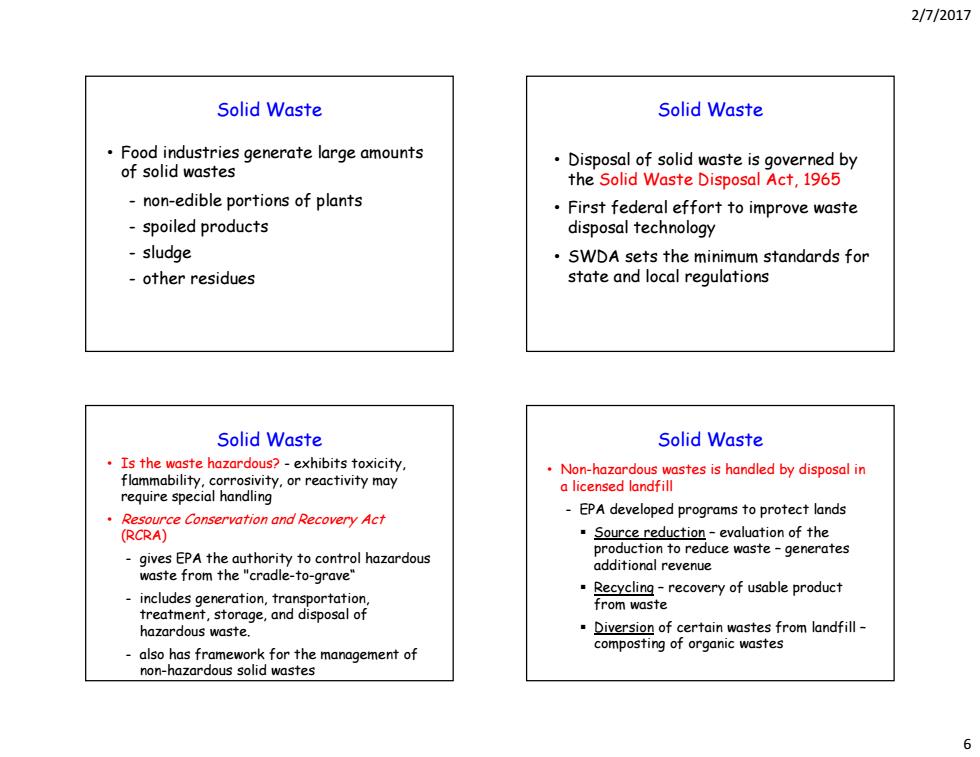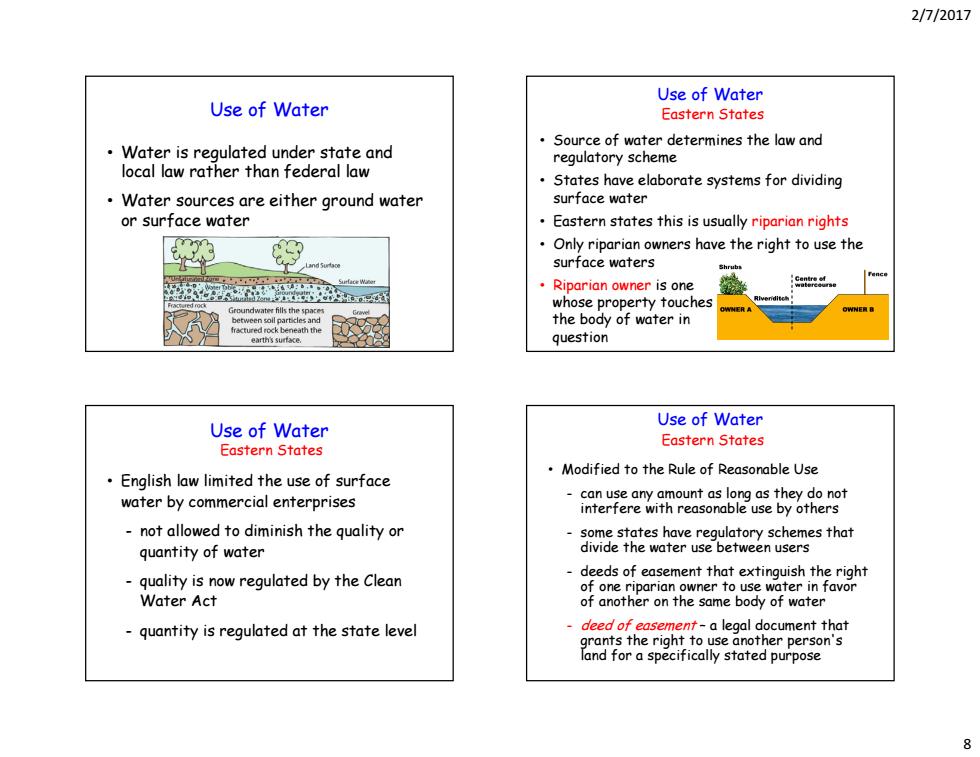
2/7/2017 Solid Waste Solid Waste Food industries generate large amounts Disposal of solid waste is governed by of solid wastes the Solid Waste Disposal Act,1965 -non-edible portions of plants First federal effort to improve waste -spoiled products disposal technology -sludge SWDA sets the minimum standards for -other residues state and local regulations Solid Waste Solid Waste Is the waste hazardous?-exhibits toxicity, Non-hazardous wastes is handled by disposal in flammability,corrosivity,or reactivity may a licensed landfill require special handling EPA developed programs to protect lands Resource Conservation and Recovery Act (RCRA) Source reduction-evaluation of the gives EPA the authority to control hazardous production to reduce waste-generates additional revenue waste from the "cradle-to-grave" .Recycling-recovery of usable product includes generation,transportation from waste treatment,storage,and disposal of hazardous waste. .Diversion of certain wastes from landfill- also has framework for the management of composting of organic wastes non-hazardous solid wastes 6
2/7/2017 6 Solid Waste • Food industries generate large amounts of solid wastes - non-edible portions of plants - spoiled products - sludge - other residues Solid Waste • Disposal of solid waste is governed by the Solid Waste Disposal Act, 1965 • First federal effort to improve waste disposal technology • SWDA sets the minimum standards for state and local regulations Solid Waste • Is the waste hazardous? - exhibits toxicity, flammability, corrosivity, or reactivity may require special handling • Resource Conservation and Recovery Act (RCRA) - gives EPA the authority to control hazardous waste from the "cradle-to-grave“ - includes generation, transportation, treatment, storage, and disposal of hazardous waste. - also has framework for the management of non-hazardous solid wastes Solid Waste • Non-hazardous wastes is handled by disposal in a licensed landfill - EPA developed programs to protect lands Source reduction – evaluation of the production to reduce waste – generates additional revenue Recycling – recovery of usable product from waste Diversion of certain wastes from landfill – composting of organic wastes

2/7/2017 Solid Waste Hierarchy Hazardous Waste Avoidance Best Generators of hazardous waste must apply to EPA and information includes Recycling application must identify Energy recovery -site land type Incineration -North American Industrial Classification without energy recovery System Code for the activity carried out contact person Landfilling Worst legal owner of the site Hazardous Waste Hazardous Waste Hazardous waste activities must be identified A manifest must follow the waste from the and classified by amount of waste produced site generated to the disposal site Transportation,treatment,and disposal are Regulatory agency must be able to find a also regulated complete paper trail for the waste Food industries do not likely produced Failure to do so will result in civil penalties hazardous wastes but activities must be evaluated Willful violations may result in criminal penalties Fluorescent light bulbs with mercury Wastes are disposed of in a licensed hazardous waste landfill
2/7/2017 7 Hazardous Waste • Generators of hazardous waste must apply to EPA and information includes - application must identify - site - land type - North American Industrial Classification System Code for the activity carried out - contact person - legal owner of the site Hazardous Waste • Hazardous waste activities must be identified and classified by amount of waste produced • Transportation, treatment, and disposal are also regulated • Food industries do not likely produced hazardous wastes but activities must be evaluated - Fluorescent light bulbs with mercury • Wastes are disposed of in a licensed hazardous waste landfill Hazardous Waste • A manifest must follow the waste from the site generated to the disposal site • Regulatory agency must be able to find a complete paper trail for the waste • Failure to do so will result in civil penalties • Willful violations may result in criminal penalties

2/7/2017 Use of Water Use of Water Eastern States Source of water determines the law and Water is requlated under state and regulatory scheme local law rather than federal law States have elaborate systems for dividing Water sources are either ground water surface water or surface water Eastern states this is usually riparian rights Only riparian owners have the right to use the surface waters Riparian owner is one ndwater fills the whose property touches the body of water in earth's surtace question Use of Water Use of Water Eastern States Eastern States Modified to the Rule of Reasonable Use English law limited the use of surface water by commercial enterprises can use any amount as long as they do not interfere with reasonable use by others not allowed to diminish the quality or some states have regulatory schemes that quantity of water divide the water use between users quality is now regulated by the Clean -deeds of easement that extinguish the right of one riparian owner to use water in favor Water Act of another on the same body of water quantity is regulated at the state level deed of easement-a legal document that grants the right to use another person's land for a specifically stated purpose
2/7/2017 8 Use of Water • Water is regulated under state and local law rather than federal law • Water sources are either ground water or surface water Use of Water Eastern States • Source of water determines the law and regulatory scheme • States have elaborate systems for dividing surface water • Eastern states this is usually riparian rights • Only riparian owners have the right to use the surface waters • Riparian owner is one whose property touches the body of water in question Use of Water Eastern States • English law limited the use of surface water by commercial enterprises - not allowed to diminish the quality or quantity of water - quality is now regulated by the Clean Water Act - quantity is regulated at the state level Use of Water Eastern States • Modified to the Rule of Reasonable Use - can use any amount as long as they do not interfere with reasonable use by others - some states have regulatory schemes that divide the water use between users - deeds of easement that extinguish the right of one riparian owner to use water in favor of another on the same body of water - deed of easement – a legal document that grants the right to use another person's land for a specifically stated purpose